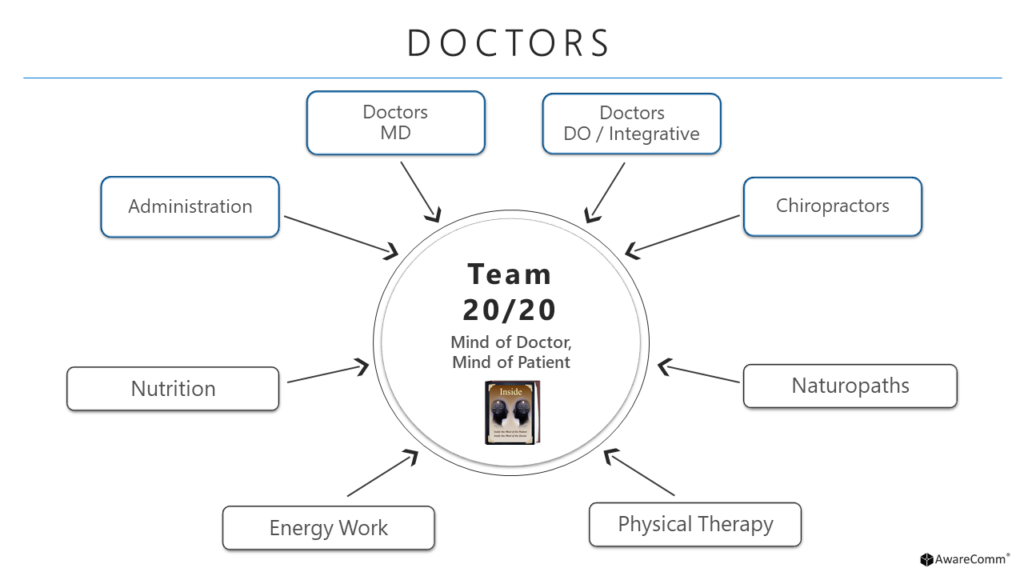
Opening Insights: Moral Injury
The health system is not set up to help patients. It’s set up to make money.
DR. NICK SAYER
Those who practice medicine today are facing a systemic challenge of corporate values that directly conflict with the Hippocratic Oath they swore to fulfill at the onset of their entrance into the field of healing people.
The term Moral Injury was first used to describe a phenomenon common to the PTSD experienced by war veterans. A Psychology Today article defines moral injury as, "a cluster of symptoms — similar to those associated with posttraumatic stress disorder (PTSD) — that result from personal experiences, which violate a person’s deepest and most closely held values and principles."
Informational Insights: Treading on the Hippocratic Oath
The following article was published by Kaiser Health News (KHN), "a nonprofit news service committed to in-depth coverage of health care policy and politics." It was written by Melissa Bailey, "Boston-based correspondent on the KHN enterprise team, focusing on aging and dying."
Dr. Keith Corl was working in a Las Vegas emergency room when a patient arrived with chest pain. The patient, wearing his street clothes, had a two-minute exam in the triage area with a doctor, who ordered an X-ray and several other tests. But later, in the treatment area, when Corl met the man and lifted his shirt, it was clear the patient had shingles. Corl didn’t need any tests to diagnose the viral infection that causes a rash and searing pain.
All those tests? They turned out to be unnecessary and left the patient with over $1,000 in extra charges.
The excessive testing, Corl said, stemmed from a model of emergency care that forces doctors to practice “fast and loose medicine.” Patients get a battery of tests before a doctor even has time to hear their story or give them a proper exam.
“We’re just shotgunning,” Corl said.
The shingles case is one of hundreds of examples that have led to his exasperation and burnout with emergency medicine. What’s driving the burnout, he argued, is something deeper — a sense of “moral injury.”
Corl, a 42-year-old assistant professor of medicine at Brown University, is among a growing number of physicians, nurses, social workers and other clinicians who are using the phrase “moral injury” to describe their inner struggles at work.
The term comes from war: It was first used to explain why military veterans were not responding to standard treatment for post-traumatic stress disorder. Moral injury, as defined by researchers from veterans hospitals, refers to the emotional, physical and spiritual harm people feel after “perpetrating, failing to prevent, or bearing witness to acts that transgress deeply held moral beliefs and expectations.”
Drs. Wendy Dean and Simon Talbot, a psychiatrist and a surgeon, were the first to apply the term to health care. Both wrestled with symptoms of burnout themselves. They concluded that “moral injury” better described the root cause of their anguish: They knew how best to care for their patients but were blocked from doing so by systemic barriers related to the business side of health care.
That idea resonates with clinicians across the country: Since they penned an op-ed in Stat in 2018, Dean and Talbot have been flooded with emails, comments, calls and invitations to speak on the topic.
Burnout has long been identified as a major problem facing medicine: 4 in 10 physicians report feelings of burnout, according to a 2019 Medscape report. And the physician suicide rate is more than double that of the general population.
Dean said she and Talbot have given two dozen talks on moral injury. “The response from each place has been consistent and surprising: ‘This is the language we’ve been looking for for the last 20 years.'”
Dean said that response has come from clinicians across disciplines, who wrestle with what they consider barriers to quality care: insurance preauthorization, trouble making patient referrals, endless clicking on electronic health records.
Those barriers can be particularly intense in emergency medicine.
Corl said he has been especially frustrated by a model of emergency medicine called “provider-in-triage.” It aims to improve efficiency but, he said, prioritizes speed at the cost of quality care. In this system, a patient who shows up to an ER is seen by a doctor in a triage area for a rapid exam lasting less than two minutes. In theory, a doctor in triage can more quickly identify patients’ ailments and get a head start on solving them. The patient is usually wearing street clothes and sitting in a chair.
These brief encounters may be good for business: They reduce the “door to doc” time — how long it takes to see a doctor — that hospitals sometimes boast about on billboards and websites. They enable hospitals to charge a facility fee much earlier, the minute a patient sees a doctor. And they reduce the number of people who leave the ER without “being seen,” which is another quality measure.
But “the real priority is speed and money and not our patients’ care,” Corl said. “That makes it tough for doctors who know they could be doing better for their patients.”
Dean said people often frame burnout as a personal failing. Doctors get the message: “If you did more yoga, if you ate more salmon salad, if you went for a longer run, it would help.” But, she argued, burnout is a symptom of deeper systemic problems beyond clinicians’ control.
Emergency physician Dr. Angela Jarman sees similar challenges in California, including ER overcrowding and bureaucratic hurdles to discharging patients. As a result, she said, she must treat patients in the hallways, with noise, bright lights and a lack of privacy — a recipe for hospital-acquired delirium.
“Hallway medicine is such a [big] part of emergency medicine these days,” said Jarman, 35, an assistant professor of emergency medicine at UC-Davis. Patients are “literally stuck in the hallway. Everyone’s walking by. I know it must be embarrassing and dehumanizing.”
For example, when an older patient breaks an arm and cannot be released to their own care at home, they may stay in the ER for days as they await evaluation from a physical therapist and approval to transfer to rehab or a nursing home, she said. Meanwhile, the patient gets bumped into a bed in the hallway to make room for new patients who keep streaming in the door.
Being responsible for discharging patients who are stuck in the hallway is “so frustrating,” Jarman said. “That’s not what I’m good at. That’s not what I’m trained to do.”
Jarman said many emergency physicians she knows work part time to curtail burnout.
“I love emergency medicine, but a lot of what we do these days is not emergency medicine,” she said. “I definitely don’t think I’ll make it 30 years.”
Also at UC-Davis, Dr. Nick Sawyer, an assistant professor of emergency medicine, has been working with medical students to analyze systemic problems. Among those they’ve identified: patients stuck in the ER for up to 1,000 hours while awaiting transfer to a psychiatric facility; patients who are not initially suicidal, but become suicidal while awaiting mental health care; patients who rely on the ER for primary care.
Sawyer, 38, said he has suffered moral injury from treating patients like this one: A Latina had a large kidney stone and a “huge amount of pain” but could not get surgery because the stone was not infected and therefore her case wasn’t deemed an “emergency” by her insurance plan.
“The health system is not set up to help patients. It’s set up to make money,” he said.
The best way to approach this problem, he said, is to help future generations of doctors understand “how decisions made at the systems level impact how we care about patients” — so they can “stand up for what’s right.”
Whether these experiences amount to moral injury is open for discussion.
Cynda Rushton, a nurse and professor of clinical ethics at Johns Hopkins University, who has studied the related notion of “moral distress” for 25 years, said there isn’t a base of research, as there is for moral distress, to measure moral injury among clinicians.
But “what both of these terms signify,” Rushton said, “is a sense of suffering that clinicians are experiencing in their roles now, in ways that they haven’t in the past.”
Dean grew interested in moral injury from personal experience: After a decade of treating patients as a psychiatrist, she stopped because of financial pressures. She said she wanted to treat her patients in longer visits, offering both psychotherapy and medication management, but that became more difficult. Insurers would rather pay her for only a 15-minute session to manage medications and let a lower-paid therapist handle the therapy.
Dean and Talbot created a nonprofit advocacy group called Moral Injury of Healthcare, which promotes public awareness and aims to bring clinicians together to discuss the topic.
Their work is attracting praise from a range of clinicians:
In Cumberland County, Pennsylvania, Mary Franco, who is now 65, retired early from her job as a nurse practitioner after a large corporation bought out the private practice she worked in. She said she saw “a dramatic shift” in the culture there, where “revenue became all-important.” The company cut in half the time for each patient’s annual exam, she said, down to 20 minutes. She spent much of that time clicking through electronic health records, she said, instead of looking the patient in the face. “I felt I short-shrifted them.”
In southern Maine, social worker Jamie Leavitt said moral injury led her to take a mental health break from work last year. She said she loves social work, but “I couldn’t offer the care I wanted to because of time restrictions.” One of her tasks was to connect patients with mental health services, but because of insurance restrictions and a lack of quality care providers, she said, “often my job was impossible to do.”
In Chambersburg, Pennsylvania, Dr. Tate Kauffman left primary care for urgent care because he found himself spending half of each visit doing administrative tasks unrelated to a patient’s ailment — and spending nights and weekends slogging through paperwork required by insurers.
“There was a grieving process, leaving primary care,” he said. “It’s not that I don’t like the job. I don’t like what the job has become today.”
Corl said he was so fed up with the provider-in-triage model of emergency medicine that he moved his ER clinical work to smaller, community hospitals that don’t use that method.
He said many people frame burnout as a character weakness, sending doctors messages like, “Gee, Keith, you’ve just got to try harder and soldier on.” But Corl said the term “moral injury” correctly identifies that the problem lies with the system.
“The system is flawed,” he said. “It’s grinding us. It’s grinding good docs and providers out of existence.”
https://khn.org/news/beyond-burnout-docs-decry-moral-injury-from-financial-pressures-of-health-care/
This article originally appeared on February 4, 2020 in KAISER HEALTH NEWS: Beyond Burnout: Docs Decry ‘Moral Injury’ From Financial Pressures Of Health Care
Kaiser Health News (KHN) is a national health policy news service. It is an editorially independent program of the Henry J. Kaiser Family Foundation which is not affiliated with Kaiser Permanente.
Possibilities for Consideration: Making a U-Turn
Sure, medical care is expensive, but to focus principally on managing costs to the exclusion of the intent of the Hippocratic Oath is to tread upon the values intrinsically required for healthcare to be effectively practiced.
Imagine what it would be like to have a steady stream of ill people, who you swore to heal "to the best of [your] ability and judgment," and you possessed the means to heal them, but in order to fulfill administrative and fiduciary requirements, those ill people remained untreated, insufficiently treated or incorrectly treated.
What would that do to you, as their caregiver?
Changing the Way Things Get Done
To overcome the challenge of misguided corporate and administrative values treading upon and replacing the socially responsible values necessarily upheld by caregivers requires a change in the way organizations are directed by their leadership. In order to be accepting of a different way of doing things, a readiness for change in individuals and their organization culture must be seeded and cultivated.
Historically, lasting change has been all but impossible to achieve for most people, organizations and cultures.
What if a lasting socially responsible change (to change the way we think, reason and act) could be successfully implemented at a community scale – one community at a time?
Awareness Communication Technology, LLC (AwareComm®) is a multi-gold certified Microsoft Research and Development partner with the mission of harnessing the collective power of Microsoft Technologies with AwareComm’s Technology, Methodology and Sentience Data Science to solve systemic organization challenges, which in turn solves systemic community challenges. This process raises Adaptive Intelligence (AdI™) and drives social-cultural change.

By raising AdI™ in individuals, teams and organizations the power for collective change is created and the power of deceive, divide and conquer is eliminated. This is the strength of collaboration and unity that the AwareComm® platform was built to propagate.
AwareComm's Team 20/20 was formed to implement a new method of partnering businesses, nonprofits and their hosting communities. For example, it's a way to unite the healthcare industry around a common set of principles and values, as it once was in times past.

If the idea of accountability and values as well as honest, open and clear intentions as a foundation to cultivate communities of caregivers is important to you then examine the questions below. If answers come to you as a result, then consider completing the SocraticQ exercise toward the bottom of this page.
Add Your Insight
Take a moment and examine…
- As you reviewed the material above, what stood out to you?
- What is the potential impact, economically and/or socially?
- What action is needed to stop or support this idea?
- You may want to consider whether you:
- want to be aware of,
- should become supportive of,
- would want to be active in this topic?
I have been impressed with the urgency of doing. Knowing is not enough; we must apply.
Being willing is not enough; we must do.
LEONARDO DA VINCI
